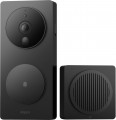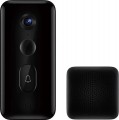Usage environment
— Street (universal). Call panels that can be used outdoors. Even in a fairly mild climate, "street" devices are constantly exposed to various adverse effects: precipitation, temperature changes, ultraviolet radiation; in addition, they can be a very attractive target for hooligans and vandals. All this requires the use of durable and sustainable materials. At the same time, nothing prevents the installation of such panels in the premises (hence the name "universal").
— Premises. Call panels designed for installation inside buildings. Such placement assumes quite favorable conditions (lack of moisture, almost constant temperature, etc.), as well as a minimal risk of vandalism. Therefore, "internal" devices do not have such a margin of safety and reliability as external ones; this has a positive effect on the cost, but does not allow the use of outdoor panels of this type outdoors.
More features
—
Motion detection. A sensor that allows the calling panel with a camera to respond to movement in the camera’s field of view. The specific reaction method may be different, depending on the model and settings of the entire system: turning on recording or broadcasting to an external device, sending a notification to the customer, sending a signal to the alarm output (see below), etc.
-
Mobile app. This feature means that you can work with the calling panel via a smartphone or tablet with a special application installed on it. Such applications are usually released immediately for both of the most popular mobile operating systems today - Android and iOS; however, it would not hurt to clarify this point separately. In any case, control from a mobile device can have very extensive functionality (including even the ability to work via the Internet, in some models); and interacting with the panel through a gadget that you can always keep with you is definitely more convenient than every time going to the intercom or other stationary equipment.
—
Face recognition. The facial recognition function is one of the types of biometric access systems. It is based on a digital camera, often complemented by a built-in backlight for identifying faces in the dark. Initially, such devices were not very accurate: they could be confused by changes in facial hair or makeup,
...the appearance or disappearance of glasses, and some models could be deceived using photography. With rare exceptions, facial recognition today uses advanced algorithms and high-end cameras with 3D scanners that read a three-dimensional model of the face. The device stores the customer library in its memory. The function is found in flagship calling panels.
— SIP protocol. The device supports the SIP protocol. This is a standard originally created for Internet telephony - the transmission of information (audio, video, special data) over telephone networks in digital format using the IP protocol (the same one on which the Internet is built). Internet telephony is quite popular nowadays, especially in business: it allows you to establish effective interaction between individual departments of a company, even tech located in different countries. Accordingly, if the building already uses equipment for Internet telephony, then SIP support can significantly facilitate the integration of the calling panel into the overall security system.
— Reading contactless keys. The presence in the design of the intercom calling panel of a module for reading data from contactless keys. They can be in the form of smart cards, key fobs or other devices that contain a microchip with a unique identifier. When the customer brings the key to the reader, the system identifies it, checks it against the database and allows access if there is a match. Note that the intercom calling panel can record not only the response time, but also the identifiers themselves - this provides advanced capabilities for access control and visitor registration.
— Alarm input/output. As a rule, calling panels with this function are equipped with both inputs and outputs; the number of both may be more than one. In general, these connectors are used to transmit control signals between different ones within a security system; they allow you to build a very advanced system and provide additional capabilities for managing its functions. At the same time, we note that the alarm input or output is not necessarily responsible for triggering the alarm - it all depends on the specific settings. For example, a signal from such an input can serve as a command to turn on the “night” IR illumination or start recording video from surveillance cameras.
— Display. Its own screen, installed directly on the calling panel, allows you to display various additional information useful for the visitor. The specific functionality of such a screen can be different - from a simple indicator that can show only numbers (for example, the number of a called apartment or office) to a full-color display suitable for two-way video communication. However, in any case, this feature increases the convenience and clarity of using the calling panel.
— Night shooting (IR illumination). The presence of an infrared illumination function in the camera video panel (see “Type”), which allows you to obtain a visible image in the dark and even in complete darkness. IR illumination is not visible to the human eye, but is well perceived by the sensors of modern digital cameras. True, the image in this mode can only be black and white, but in most cases this is not any significant drawback.
— LED backlight. The camera video panel (see “Type”) has LED backlighting. Like the infrared illumination described above, this backlight is designed to work in the dark; however, it provides light that is visible to the human eye. The latter, on the one hand, allows the camera to produce a relatively natural color image, on the other hand, it can create inconvenience for the guest due to the bright light in the eyes.
— Illuminated buttons. The design of the calling panel includes backlit buttons. The function allows you to see the keyboard normally even in low light conditions - in the evening, at night, in cloudy weather, when placing the panel in a dark place, etc. Note that the backlight usually covers other significant elements of the panel - for example, the location of the sensor for a smart card or key.Card reader
A card reader is a device for working with removable memory cards. Such media are used to record data, which allows you to save events occurring in front of the calling panel at the right time.
Matrix type
Type of matrix installed in the camera of the video panel (see "Type").
— CMOS. She is CMOP. Relatively inexpensive matrices, which, nevertheless, provide good image processing speed with low power consumption, and also take up little space (which is very important for miniature cameras). Their main disadvantage is the increased tendency to the appearance of noise in the image, which is why the quality of this image is somewhat inferior to CMOS CCD.
— CCD. The Russian equivalent of the name is "PZS". Such sensors are somewhat more expensive than CMOS, due to the complexity of the design, and their size is somewhat larger. At the same time, they have more uniform characteristics and are not as prone to heat during operation, which reduces noise and has a positive effect on image quality — especially with a small amount of light.
Megapixels
The number of megapixels in the camera sensor, in other words, its resolution. A megapixel is one million light-sensitive dots (pixels) that make up an image; the resolution of modern matrices is very high, so it is more convenient to use just this method of designation. However, for call panels, the values are
1 MP,
1.3 MP and
2 MP. More advanced options are extremely rare.
The higher the resolution of the matrix, the higher the video resolution can be (see below), the more detailed the image can be provided by the door panel camera. At the same time, note that as the number of megapixels increases (without changing the size of the matrix), the size of each individual pixel decreases, which increases the likelihood of noise and deterioration in the overall image quality. Therefore, high resolution in itself is not necessarily a sign of high quality — a lot depends on other things, for example, on the size of the matrix (see above).
Video resolution
The maximum video resolution that the call panel camera can provide.
The higher the resolution of the video, the more details you can see on it, the less details will be blurry. On the other hand, high resolution means large volumes of video materials, which, accordingly, requires fast communication channels, and this indicator significantly affects the cost of the device.
Vertical viewing angle
The vertical size of the video panel covered by the camera (see "Type"), in other words, the angle between two lines connecting the lens with the top and bottom edges of the scene being viewed. The value of the viewing angles is described in detail above in paragraph "Viewing angles horizontally"; we only note that they are usually smaller vertically than horizontally, and in many models this parameter is not indicated at all because of its secondary importance.
Diagonal viewing angle
This value characterizes the angle of coverage of the image diagonally, this figure is usually slightly larger than the horizontal angle, this is due to the fact that the frame that we see is already in a rectangular form, usually with an aspect ratio of 3 to 4 or 16 to 9, and part of the frame can be circumcised. This indicator, along with the horizontal and vertical viewing angles, allows you to estimate from what distance the visibility of the interlocutor will be acceptable.
Operating temperature
The operating temperature range of the call panel is the air temperature at which the device is guaranteed to remain operational.
If the panel will be used in a residential apartment, house, office or other premises with similar conditions, you can ignore this indicator: all modern models have a temperature range that is more than sufficient for such conditions. But if the device is planned to be installed on the street, it is necessary to make sure that its operating temperatures correspond to climatic features. It is worth noting here that nowadays panels are produced both for
very cold weather (-30 °C and below), and for
extreme heat(+50 °C and more). A high temperature threshold is also important if the device will be exposed to direct sunlight — under sunlight, the case can heat up to very high temperatures, noticeably higher than that of the surrounding air. And some models combine frost and heat resistance.

